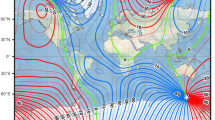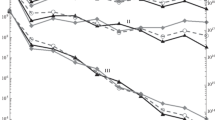Summary
Recently excellent archeomagnetic data sequences have been bublished from several parts of the world. Using these sequences, an attempt is made to trace the secular variation of the virtual geomagnetic dipole field characterized by the three first order spherical harmonic coefficients\(\bar g_1^0 ,\bar g_1^1 and\mathop h\limits^-- _1^1 \). The archeomagnetic data (declination, inclination and total intensity) are transformed into the first order coefficients mentioned by a simple mathematical method. The secular variations of these coefficients, however, contain both dipole and non-dipole components. The separation of these is also attempted.
Similar content being viewed by others
General References
E. C. Bullard, C. Freedman, H. Gellman andI. Nixon:The westward drift of the earth's magnetic field, Phil. Trans. Roy. Soc. London [A]243 (1950), 67–92.
A. Cox:Analysis of present geomagnetic field for comparison with paleomagnetic results, J. Geomagn. Geoelectr.13 (1962), 101.
N. Kawai, K. Hirooka, andS. Sasajima:Counter-clockwise rotation of the geomagnetic dipole axis revealed in the world-wide archeo-secular variations, Proc. Japan Acad.41 (1965), 398.
N. Kawai andK. Hirooka:Wobbling motion of the geomagnetic dipole field in historic time during these 2000 years, J. Geomagn. Geoelectr.,19, No. 3, (1967), 217–227.
T. Nagata:Main characteristics of recent geomagnetic secular variation, J. Geomagn. Geoelectr.17, No. 3-4 (1965), 263–276.
P. J. Smith:The intensity of the ancient geomagnetic field: A review and analysis, Geophys. J. Roy. Astron. Soc.12 (1967), 321–362.
E. H. Vestine, L. Laporte, C. Cooper, I. Lange andW. C. Hendrix:Description of the earth's main magnetic field and its secular change, 1905–1945, Publ., Carneg. Inst., No. 580 (1947).
References with Archeomagnetic Data
M. J. Aitken andG. H. Weaver:Recent archeomagnetic results in England, J. Geomagn. Geoelectr.17, No. 3-4 (1965), 391–394.
R. N. Athavale:Intensity of the geomagnetic field in India over the past 4,000 years, Nature No. 5043 (1966), 1310–1312.
J. C. Belshé:Archeomagnetism. An indirect study of geomagnetic secular variation, inVistas in astronomy 4 (Pergamon Press, Oxford a. o. 1961).
S. P. Burlatskaya:Archeomagnetism (in Russian) (Izdatyelstvo ‘Nauka’, Moscow 1965).
S. P. Burlatskaya, T. B. Nechayeva andG. N. Petrova: Akad. Nauk SSSR, Physics of the Solid Earth No. 6 (1965), 380.
M. Kovacheva-Nozharova:Ancient magnetic field in Bulgaria, Compt. Rend. Acad. Sci. (Bulgaria)21, No. 8 (1968), 761–763.
T. Nagata, Y. Arai andK. Momose:Secular variation of the geomagnetic total force during the last 5000 years, Journ. Geophys. Res.,68 (1963), 5277–5281.
T. Nagata, K. Kobayashi andE. J. Schwarz:Archeomagnetic intensity studies of South and Central America, J. Geomagn. Geoelectr.17, No. 3-4 (1965), 399–405.
M. Puskás:Archeomagnetism (in Hungarian), Manuscript (1968).
S. Sasajima:Geomagnetic secular variation revealed in the baked earth's in west Japan (part 2),Change of the field intensity, J. Geomagn. Geoelectr.17, No. 3-4 (1965), 413–416.
J. Sipos:Archeomagnetism (in Hungarian), Manuscript (1967).
P. J. Smith:Ancient geomagnetic field intensities I–II, Geophys. J. Roy. Astron. Soc.13 (1967), 417–419 and 483–486.
E. H. Tarchov:A study of secular variation of geomagnetic field by archeomagnetic method (in Russian).
E. Thellier andO. Thellier:Sur l'intensité du champ magnétique terrestre dans le passé historique et geologique, Annales de Géophysique15, fasc. 3 (1959), 285–376.
N. Watanabe:Secular variation in the direction of geomagnetism as the standard scale for geomagnetochronology in Japan, Nature No. 4632 (1958), 383–384.
N. Watanabe andR. L. DuBois:Some results of an archeomagnetic study on the secular variation in the southwest of North America, J. Geomagn. Geoelectr.17, No. 3-4 (1965), 395–397.
B. M. Yanofsky:Geomagnetism (in Russian) (Izdatyelstvo Len. Univ. 1964).
Author information
Authors and Affiliations
Rights and permissions
About this article
Cite this article
Márton, P. Secular variation of the geomagnetic virtual dipole field during the last 2000 years as inferred from the spherical harmonic analysis of the available archeomagnetic data. PAGEOPH 81, 163–176 (1970). https://doi.org/10.1007/BF00875023
Received:
Issue Date:
DOI: https://doi.org/10.1007/BF00875023




